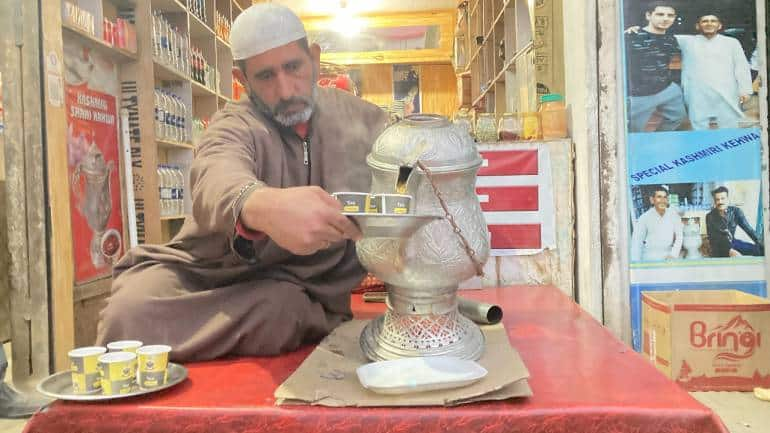



The brutally cold winter spell lashing northern India is sending people scurrying into their razais while accelerating their quest for warmth-inducing foods. Plummeting temperatures increase metabolism which generates more bodily heat while also heightening one’s cravings for warmer foods, say experts.
There’s a good reason why the markets are flooded with root vegetables during winter like carrots, radishes, yams, turnips and beetroots. Loaded with antioxidants, vitamin C and micronutrients like potassium, phosphorous, magnesium, beta-carotene, they are a powerhouse of nutrition and warmth. As these vegetables take a longer time to digest, it helps keep the body warm, suggest nutritionists.
 (Photo courtesy ITC Maurya)
(Photo courtesy ITC Maurya)Ayurveda terms this as 'Ritucharya’ – or the principle of modifying one’s lifestyle and diet seasonally. “In summers, our body requires more hydration and light foods. In winters, the body works harder to maintain a higher temperature which requires more energy from richer and more nourishing foods,” says Ruchi Gulati, founder, Sukh Ayurveda, Noida, Uttar Pradesh.
Gulati adds that the human body is made up of three life energies or doshas – Vata, Pita and Kapha. “Balanced doshas create equilibrium, leading to optimal health. In winter, we have to pacify the 'vata’ component. Vata signifies air and space, and its imbalance can trigger ailments like stomach bloating, indigestion, joint aches, skin dehydration and ear pain.”
Warming spices like cinnamon, clove, cardamom, nutmeg work well in such cases. They are wholesome and provide that little burst of heat for a warm, cozy feeling, adds Gulati. Sesame seeds, ghee, gur, saunth (dried ginger powder), resin (gond) and ashwagandha achieve the same purpose.
“Gut-friendly beverages like kanji with black carrots and shilajit (sticky, black tar-like substance) with hot milk are good for the chilly season. Grains like corn in the form of makki ki roti as well as sarson ka saag, fenugreek breads, etc., keep the body warm and diseases at bay. All these items are hard to digest but in winters the body’s digestive powers get bolstered, so they’re easily assimilated,” explains the acharya.
Hotels, too, are leveraging the fresh winter produce to curate menus of warming, healthful foods. Shubhra Mehrotra, Executive Sous Chef, ITC Maurya, says: “This winter, we’re using a lot of millets like bajra, jowar and nachni to make breads, curries and desserts."
Mehrotra cites the example of Bajre ka soeta—a gruel of bajra simmered for five hours and topped with ghee, mint and fried brown onions just before serving, and Nihari—Awadhi lamb stew that is slow-cooked on charcoal and finished with saffron.
The hotel is also serving amaranth koftas, kebabs; ragi dosa, idli, bajra and raagi roti. At the hotel’s coffee shop—Pavilion—Haleem, both veg (mixed lentils) and non-veg (lamb) version, are available. “We also make a jackfruit haleem whose recipe in unique to our hotel. Kunni Dal or black lentils cooked with gram dal is another specialty,” says Mehrotra.
 A kahwa seller in Kashmir (Photo by Irfan Amin Malik)
A kahwa seller in Kashmir (Photo by Irfan Amin Malik)Beverages like saffron-infused Kashmiri kahwa and ginger-infused tea and desserts like carrot halwa, and sesame-encrusted sweet treats like gajak and rewri which not only keep one warm but also aid digestion are being showcased at the hotel, adds Mehrotra.
Ayurvedic influencer Dr Dimple Jangda recommends the use of pearl millets (bajra). Sharing a recipe on her Instagram account where she has 409,000 followers, she advocates drinking 'Bajra Raab’, made with bajra flour, ginger and ajwain (carom seeds) which she says also strengthens the immune system.
The trinity of onion-garlic-ginger also makes for excellent winter foods, says wellness expert Ayushi Khullar. “These are thermogenic substances which not only generate bodily heat but also boost one’s metabolism and help in weight reduction. Ginger—consumed raw or in beverages like tea or kada—is very helpful in preventing sniffles. Onions—considered as a 'Chi' or an 'energizing tonic' in traditional Chinese medicine—can be incorporated in soups, salads or cooked veggies. Roasted in ghee, their potency to keep one warm surges manifold,” says Khullar.
Dry fruits—rich in nutrients, dietary fibre, vitamins—are considered as one of the most potent foods for the winter months. Store up on apricots, dried figs, dates, almonds and cashews to provide essential nutrients to the body, adds Khullar. Curcumin-rich turmeric (raw and ripe), now accepted as a superfood, also enhances blood circulation and works like a health tonic when combined with hot milk, she suggests.
Discover the latest Business News, Sensex, and Nifty updates. Obtain Personal Finance insights, tax queries, and expert opinions on Moneycontrol or download the Moneycontrol App to stay updated!
Find the best of Al News in one place, specially curated for you every weekend.
Stay on top of the latest tech trends and biggest startup news.